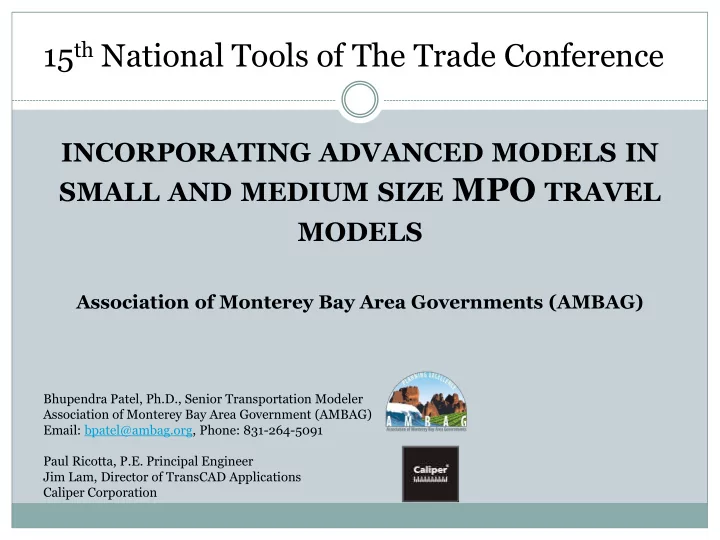

15 th National Tools of The Trade Conference INCORPORATING ADVANCED MODELS IN SMALL AND MEDIUM SIZE MPO TRAVEL MODELS Association of Monterey Bay Area Governments (AMBAG) Bhupendra Patel, Ph.D., Senior Transportation Modeler Association of Monterey Bay Area Government (AMBAG) Email: bpatel@ambag.org, Phone: 831-264-5091 Paul Ricotta, P.E. Principal Engineer Jim Lam, Director of TransCAD Applications Caliper Corporation
Monterey Bay Area Central Coast of California Metropolitan Planning Organization (MPO) Covering 3 Counties, 18 Cities 735,708 Population in 2010 66% Population live in cities 885,000 Population by 2035 Major Employment: Agriculture, Service, and Government
Modeling Challenges Influence of SF Bay Area Heavy commuter trips, telecommuting, flex schedule, work from home Job-Housing Imbalance Coastal area vs. inland rural county area Agriculture activities Farm workers are transient/ seasonal Aging population (65 +) Attracts service trips, retirement homes Longer trip length Tourists attractions Weekend, seasonal variation and special events
AMBAG RTDM Updates AMBAG Regional Travel Demand Model (RTDM) recently underwent a significant overhaul Completely re-estimated using local survey data Implements Short and Medium Term Improvements recommended by 2011 TMIP Peer Review panel Considers Long-term improvement strategy A step closer to an Activity Based Model (ABM) Upgrade travel model in response to; Better measure transportation and land use relations Integrate GHG modeling to address SB375 requirements
Hybrid Approach Implements advanced practice techniques such as population synthesis to drive a disaggregate trip generation Destination choice modeling to aid in better alignment of housing to job location Provide increased model sensitivity to land use changes and 4D measures (Density, Diversity, Design, and Destinations) Capture individual-based travel behavior Streamline reporting to increase productivity and efficiency D Variables fully integrated with Destination Choice and Mode Choice model components
Trip Generation Disaggregated trip generation approach Population Synthesis Sophisticated nested population synthesis routine Anchoring the socio-economic component Productions calculated on a person basis Population derived from a synthetic population Match totals of HH’s by: Size at Block level and Income Category, Workers, Auto Ownership at Block Group level Persons over 65 years of age and under 18 years of age residing in household at Block Group Estimating future years synthetic population is a challenge
Trip Distribution Fully estimated destination choice framework Assists in better aligning workers with their job locations Deployed destination choice model Other home-based trip purposes to better align non-work travel choices Includes shadow pricing to match attraction totals Utilizes a tract-based approach for choosing destination “D” measures incorporated for several purposes wherever found to be significant in model formulation. Continued use of Gravity for purposes thought to be more proximity-based (e.g., NHBW/NHBO)
Mode Choice Structure
Mode Split Significant upgrade to nested logit structure Utilizing a completely estimated formulation Utilizes “D” measures wherever they were found to be significant Allowing sensitivity to changes in land use policy resulting in increased accessibility to destinations via transit or non- motorized modes. Exceptional match on observed mode shares
Daily Flows (%RMSE: 29.73) 70000 60000 50000 Assigned Flow (vpd) 40000 30000 20000 10000 0 0 10000 20000 30000 40000 50000 60000 Count (vpd) Flow vs. Count Linear (Flow vs. Count)
Recommend
More recommend